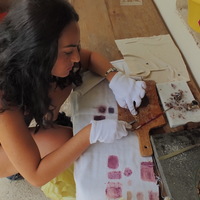- Antropologia del Vicino Oriente antico, Ancient Textiles, Landscape Archaeology, Zooarchaeology, Cultural Ecology, Ecological Anthropology, and 15 moreFolklore Archeology, Ancient Religion, Paleoeconomy, Cultural Anthropology, Food History, Aegean Prehistory (Archaeology), Aegean Bronze Age (Bronze Age Archaeology), Ethnobotany, Ethnobotany, Ethnobiology, Ethnoecology, Textile Printing, Dyeing and Finishing, Purple dye production, Mitologia, Cypriot Archaeology, Ancient Near East (Archaeology), and Cultural interrelations in the eastern Mediterranean from the BA to the EIAedit
- Exploitation of resources of Bronze Age in the Eastern Mediterranean and ancient Near East. Ecological and semiotic value of raw materials in Society, Economy and Art.edit
The cuneiform archives of Mari (18th century BC), in the Middle Euphrates region, shine light on the strong commercial links with Crete, Cyprus as well as the Semitic kingdoms of Yamkhad, Qatna, Ugarit, Byblos and Hazor. Minoan Kamares... more
The cuneiform archives of Mari (18th century BC), in the Middle Euphrates region, shine light on the strong commercial links with Crete, Cyprus as well as the Semitic kingdoms of Yamkhad, Qatna, Ugarit, Byblos and Hazor. Minoan Kamares pottery was discovered in all these cities, providing material evidence of a blossoming overseas trade between communities in the Middle Bronze Age Syria, Canaan and Aegean. Moreover, in spite of large-scale textile production within the kingdom, the texts of Mari record the importation of wool, textiles and fabrics from the above-mentioned western cities and from the island of Crete. The cuneiform tablets reveal a particular appreciation for “Mediterranean fashion” though they do not provide any indication of why. The discovery of an original western typology of loom weights in the Middle Bronze Age II levels of some Canaanite sites suggests that at the time of the Mari archives there was a sort of “textile technological koinè” based on the circulati...
Research Interests:
Research Interests:
Soriga, E. (2013), "Geografia dei tessuti. Toponomastica e industria tessile antica", in Alberto Manco (a cura di), Toponomastica e Linguistica. Nella storia, nella teoria, Collana Quaderni di AION-Linguistica, Università degli studi di... more
Soriga, E. (2013), "Geografia dei tessuti. Toponomastica e industria tessile antica", in Alberto Manco (a cura di), Toponomastica e Linguistica. Nella storia, nella teoria, Collana Quaderni di AION-Linguistica, Università degli studi di Napoli "L'Orientale", Napoli, pp. 237-276.
L'impatto che la tecnologia tessile ebbe nell'organizzazione sociale e nell'economia delle comunità umane fin dall'età del Bronzo influì grandemente sulla stessa percezione del paesaggio e del territorio, intesi dalla popolazione che vi abitava sia come la realtà ecologica in cui reperire o produrre le risorse e le materie prime necessarie al processo produttivo sia come mercato in cui spacciare i prodotti finiti. Considerando inoltre la fortissima valenza culturale, identitaria e ideologica che è intrinseca nei tessuti oggi come nell'antichità, il presente contributo intende investigare alcuni toponimi conosciuti nel III, II e I millennio a.C. nel cui etimo è ancora rintracciabile l'eco dell'importanza di alcune materie prime connesse alla produzione di stoffe quali le tinture coloranti. L'articolo si focalizza in particolare sul ruolo tecnologico, culturale e ideologico che la porpora marina e prima ancora lo zafferano ebbero nell'industria tessile antica tanto da contribuire alla formazione di toponimi reali e fantastici piuttosto noti ancora durante il I millennio a.C.
L'impatto che la tecnologia tessile ebbe nell'organizzazione sociale e nell'economia delle comunità umane fin dall'età del Bronzo influì grandemente sulla stessa percezione del paesaggio e del territorio, intesi dalla popolazione che vi abitava sia come la realtà ecologica in cui reperire o produrre le risorse e le materie prime necessarie al processo produttivo sia come mercato in cui spacciare i prodotti finiti. Considerando inoltre la fortissima valenza culturale, identitaria e ideologica che è intrinseca nei tessuti oggi come nell'antichità, il presente contributo intende investigare alcuni toponimi conosciuti nel III, II e I millennio a.C. nel cui etimo è ancora rintracciabile l'eco dell'importanza di alcune materie prime connesse alla produzione di stoffe quali le tinture coloranti. L'articolo si focalizza in particolare sul ruolo tecnologico, culturale e ideologico che la porpora marina e prima ancora lo zafferano ebbero nell'industria tessile antica tanto da contribuire alla formazione di toponimi reali e fantastici piuttosto noti ancora durante il I millennio a.C.
